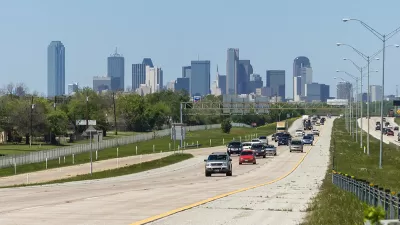Some commentators argue that sprawl is an inevitable result of affluence, based on European development patterns. These pundits tell a simple story: European urban cores are losing population and becoming more automobile-dependent - just like American cities. So if Europe can’t beat sprawl, neither can America.
Some commentators argue that sprawl is an inevitable result of affluence, based on European development patterns. These pundits tell a simple story: European urban cores are losing population and becoming more automobile-dependent - just like American cities. So if Europe can't beat sprawl, neither can America.
But in fact, this theory is based on questionable factual assumptions. To be sure, many European cores did lose population in the late 20th century. But in recent years, European cores have rebounded. Between 1991 and 2004, 15 of 27 European national capitals gained population. (1) Among the eleven European cities with over 1 million people, six (Vienna, London, Paris, Hamburg, Munich, and Madrid) gained population.(2)
Moreover, European transit ridership is in fact growing. In all five of the largest Western European nations (Germany, Spain, France, Italy and the U.K.) kilometer-miles of bus and train travel grew between 1995 and 2003- in four cases (all but Germany) by between 12 and 33 percent.(3) By contrast, population in these countries increased by 6 percent or less. (4) Even if one measures automobile dependence by market share, the results are more ambiguous than pro-sprawl pundits suggest: in the fifteen nations originally comprising the European Union, the automobile's market share has fluctuated between 84.3 and 85 percent every year since 1994- hardly a rapid increase in car dependency. (5) And in France and the United Kingdom, the "automobile market share" actually declined.
Admittedly, these trends differ from the more sprawling trends of the late 20th century. But to the extent Europe did sprawl, those results may have been a result not of the free market or affluence, but a result of pro-sprawl government policies. European highway networks expanded enormously in the late 20th century; for example, Spain's road network expanded from 387 miles to 11,432 miles between 1970 and 2005.(6) In the short run, highways make driving easier and may shift development to places with minimal transit service. In the absence of such pro-sprawl policies, Europe might have sprawled less.
But today, the tide of European sprawl is ebbing- thus indicating that sprawl is not as inevitable as some think.
(1) EUROPEAN COMMISSION, EUROSTAT REGIONAL YEARBOOK 2007 at 77.
(2) For detailed statistics go to www.citypopulation.de
(3) See Eurostat, Transport Tables, available at http://epp.eurostat.ec.europa.eu/portal/page?_pageid=1996,45323734&_dad… (click on links for "Rail transport of passengers" and "Bus transport of passengers, and add links together")
(4) See U.S. Census Bureau, 2004-05 Statistical Abstract at 841-43.
(5) See Eurostat Transport Tables, supra note 3 (click on link for "Car share of inland passenger transport").
(6) European Union, Statistical Pocketbook 2007, Part 3.5.1, available at http://ec.europa.eu/dgs/energy_transport/figures/pocketbook/doc/2007/2007_transport_en.pdf (visited March 11, 2008).

Planetizen Federal Action Tracker
A weekly monitor of how Trump’s orders and actions are impacting planners and planning in America.

Maui's Vacation Rental Debate Turns Ugly
Verbal attacks, misinformation campaigns and fistfights plague a high-stakes debate to convert thousands of vacation rentals into long-term housing.

San Francisco Suspends Traffic Calming Amidst Record Deaths
Citing “a challenging fiscal landscape,” the city will cease the program on the heels of 42 traffic deaths, including 24 pedestrians.

Defunct Pittsburgh Power Plant to Become Residential Tower
A decommissioned steam heat plant will be redeveloped into almost 100 affordable housing units.

Trump Prompts Restructuring of Transportation Research Board in “Unprecedented Overreach”
The TRB has eliminated more than half of its committees including those focused on climate, equity, and cities.

Amtrak Rolls Out New Orleans to Alabama “Mardi Gras” Train
The new service will operate morning and evening departures between Mobile and New Orleans.
Urban Design for Planners 1: Software Tools
This six-course series explores essential urban design concepts using open source software and equips planners with the tools they need to participate fully in the urban design process.
Planning for Universal Design
Learn the tools for implementing Universal Design in planning regulations.
Heyer Gruel & Associates PA
JM Goldson LLC
Custer County Colorado
City of Camden Redevelopment Agency
City of Astoria
Transportation Research & Education Center (TREC) at Portland State University
Jefferson Parish Government
Camden Redevelopment Agency
City of Claremont




























